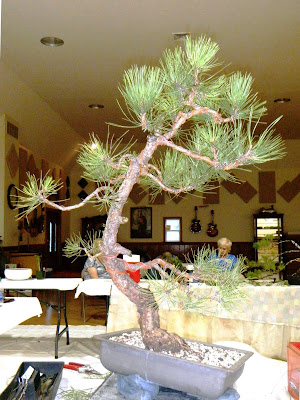 |
| Hard akadama, maximum particle size about 5 mm. |
Since my first blog post about akadama two years ago, I think I can safely say that my understanding of the subject has become a little more nuanced. In particular, I've learned more about akadama use in a climate like mine: temperate, freezing temperatures in winter, 40 inches of precipitation in an average year. (And in spring, a tendency to go from shirtsleeves to sleet within 24 hours!)
In my last post I mentioned that Andrea Wigert and Adam Lavigne, both in Florida, told me that they don't use akadama in their respective planting mixes because it stays too wet in their rainy climate. I decided to seek the input of a bonsai professional in a climate a lot more like mine. So I contacted a man from whom I've already learned a lot, Mark Fields, of Bonsai by Fields LLC in Indianapolis.
I particularly wondered if Mark uses akadama in his planting mix for ponderosa pine (Pinus ponderosa). I have a yamadori ponderosa from Golden Arrow Bonsai that is due for repotting this spring. Ryan Neil, of Bonsai Mirai, recommends akadama very highly, and I had the components to duplicate his ponderosa mix, a 1:1:1 blend of akadama, pumice and scoria. But first, I wanted to get the thoughts of an experienced grower closer to home. A big "Thank you!" to Mark for discussing the question with me in a series of emails. 😄
Here is what Mark told me.
- First, he uses akadama or an akadama blend for everything except ponderosa pines and California junipers. For those species, he substitutes a product called calidama. As I understand it, calidama is a fired-clay product which absorbs water very slowly and releases it very slowly.
- Mark allows his temperate-zone trees to freeze over the winter, in a cold greenhouse. It's been his experience that akadama goes into winter still holding enough water that, once it freezes, the particles at the surface, exposed to the air, disintegrate into dust by spring. He didn't say so, but I presume that with a dryland species like ponderosa, Mark doesn't want to take a chance on that dust building up over time and clogging the pores of the soil. With other species, he simply tilts the pots up in the spring and brushes off the dust.
- Akadama particles below the surface, in Mark's observation, retain their structural integrity.
My climate, here in what many call "Michiana", is both a little colder and a little drier than Mark's in Indianapolis. But after reading of the freezing-and-crumbling, I had almost concluded that I had best not use Ryan Neil's ponderosa mix, which is one-third akadama, but devise something myself.
Then I got an unexpected chance to ask Ryan directly whether he has ever had the problem Mark described: that of akadama on the surface freezing and crumbling. (His location does get freezing temperatures in winter.) He answered that he hasn't, and attributes that fact to the use of a top dressing of shredded sphagnum, which acts as a bit of a blanket over the surface particles.
So - with great respect for Mark Fields, and great appreciation for his helpfulness and input - I have decided to use Ryan's recipe, that 1:1:1 mix of akadama, scoria and pumice. I admit I made the decision with some trepidation! And if the tree should suffer as a result, the responsibility is of course mine alone.
Repotting is set for tomorrow morning, once the anticipated rain clears out. The tree is ready, the mix is ready, the pot is ready, and I'm ready. I'll let you all know how it goes in a future post. Here's the tree, after first styling in a workshop with Andy Smith last summer.

Interesting perspective; thanks, Steve. As far as I know Calidama is no longer available.
ReplyDeleteGlad you found it interesting, Jeff. I wonder if Mark Fields know Calidama is off the market?
Delete